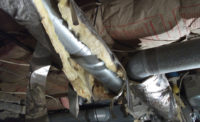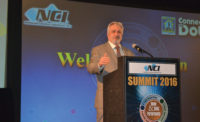Savvy HVAC contractors are always looking for ways to differentiate their companies from the competition. Becoming a “commoditized box-seller” makes it too easy for customers to simply press you for the lowest price, which is not a formula for success.
Offering home-performance services, on the other hand, can set a contracting business apart from its competition, help bring in new business from both existing and new customers, and create interesting work for its employees, all while providing a comfortable and safe home for your customers.
Mark Pippin, co-owner of Pippin Brothers Home Services in Lawton, Oklahoma, said his company has been involved in home-performance contracting since about 1999, and he can attest to its merits.
“We were one of the first members of the National Comfort Institute Inc. [NCI],” Pippin said. “We knew that once we started measuring the performance of air conditioning systems, which includes the ductwork, it was going to set us apart from everyone else. We were amazed to learn just how poorly the average duct system performs. We had been replacing units for years, and we had no idea that we were hooking them up to such bad systems.”
Pippin Brothers’ efforts began to really pay off in 2011 when the local utility, Public Service of Oklahoma (PSO), began a rebate program for homeowners who had home-performance work done. The program featured rebates so large — up to a maximum of $8,500 — that, at first, homeowners seemed to believe they lacked credibility.
“The rebates were so ridiculous that when we advertised them, we received no response,” Pippin said. “We sent out direct mail pieces and put the word out on television and got nothing. Then, when it finally started happening, it snowballed, and our business went crazy.”
Although much of the PSO program was based on air-sealing doors and windows and adding insulation, Pippin said his company always continued its focus on ductwork. He found that simply fixing a home’s ductwork and sealing around doors and windows could make a home 70 percent tighter.
“While we do a lot of insulation and air sealing, we’re still invested in airflow,” Pippin said. “Systems don’t work unless you have proper airflow, and people to this day still don’t realize that.”
Pippin noted that competition in his market peaked at about 13 home-performance contractors during the height of the rebate program, but, today, there are only about three contractors, because it’s a tough and time-consuming business.
“Some companies can change out two systems a day, but we’re lucky if we can complete one in two days because of the extra effort we put into the airflow,” he said. “Most contractors just don’t want to deal with it, but we stick with it because we believe in it. And we’re still different from anyone else because we not only get the system tight, we balance it. Improper airflow can cause a lot of problems, such as callbacks, comfort issues, and even unit breakdowns because of high static pressures. So, there’s still a niche to be carved out in home performance if you know airflow.”
BUILD SUCCESS OVER TIME
Rob Basnett, president of Basnett Plumbing and Heating in Littleton, Massachusetts, said contractors entering the home-performance arena shouldn’t expect success overnight. He attained his certification from NCI in 2011, but his company didn’t begin rolling out home-performance services until 2013. And it wasn’t until 2015 that the home-performance side of the business really took off.
Basnett said he took his time to seek input from his people and fully involved them in the process to ensure they had the procedures down to a science. As everyone at the company began to realize how poorly designed and installed many existing HVAC systems were — and realized they had the knowledge and skills to fix them — the magnitude of these opportunities became apparent.
“Performance contracting was really a way to separate our company from the competition and do the right things,” he said.
Educating homeowners and selling home performance remains a challenge, and the services aren’t for everyone, Basnett noted. By selling a home evaluation, which may cost $500, the Basnett team is more apt to help customers solve their comfort and energy challenges.
“Performing an evaluation gives us the opportunity to go in and measure airflow and other system parameters,” Basnett said. “After this evaluation, we can help customers understand what’s going on with their systems and help them decide if they want to move forward. Not all homeowners are going to want to spend the money necessary to fix their poorly performing systems, so be prepared for that.”
When it comes to home-performance contracting, solutions are more important to homeowners than rebates or other incentives, Basnett added.
“We sell solutions, not just identify problems,” he said. “No homeowner wants to hear, ‘Your system is terrible, your insulation is inadequate, and you’re stuck with it.’ After our evaluations, we present menu pricing to help customers understand what the next steps are when it comes to their unique situations. It’s never one-size-fits-all.”
The field of home-performance contracting will continue to grow in the future, said Basnett; however, just as it’s not for every customer, it’s also not for every contractor.
“Many contractors simply don’t have the knowledge and don’t want to do what it takes to obtain it,” he said. “They just want to swap out boxes and be done with it. And that’s good for us, because it keeps us busy.”
THE VALUE OF TRAINING AND CERTIFICATION
Joe Hall, owner of Joe Hall Energy Consulting LLC in Lakewood, Colorado, trains and certifies workers, including HVAC contractors, in the public and private sectors of the home-performance industry. He started his training and consulting company in 2011, and today he serves as a contract trainer for a number of community colleges in the West and Midwest. He also works with distributors and manufacturers to provide training and certification for their contractor customers. He is an energy rater for the Building Performance Institute Inc. (BPI) and serves on a committee with the National Renewable Energy Laboratory (NREL) to help refine the Home Energy Professional (HEP) certifications and further professionalize the industry.
“Successful contractors have trained and certified staff,” Hall said. “They have either North American Technician Excellence [NATE] or BPI certifications and perform actual Manual J load calculations. They have people on staff who know how to operate a Minneapolis Blower Door and The Energy Conservatory’s Duct Blaster.”
Beyond training and certification, a true knowledge of and belief in the power of home-performance contracting is essential.
“You must subscribe to the whole-house theory, which, frankly, has moved beyond theory to fact,” Hall said. “The best home-performance contractors understand that a house is made up of subsystems that all interact, and they have the ability to look past just what their box does and understand how it fits into the whole. They understand there’s much more to solving comfort problems than just going in and slapping in a different box.”
And, while it’s always important for all contractors to put customers’ needs first, Hall stressed this is especially crucial for home-performance contractors.
“As a home-performance contractor, your job is to cut through the crap and inform homeowners of what is going on in their homes and what products and services can move them toward their goals — not just sell them the products you carry,” he said.
The payoff for contractors comes in the form of interesting work, as every house you enter is a mystery waiting to be solved.There’s also a sense of satisfaction for truly taking care of customers’ comfort challenges, and, of course, it’s more profitable work, said Hall.
“You can certainly charge more when you get the reputation of being a problem-solver,” Hall noted. “And there is great growth potential in home-performance contracting. Just be sure you do your work well and don’t green wash customers by learning a few catchphrases. The codes are becoming more stringent, and code officials are becoming more educated. Apply whole-house thinking to truly solve customers’ comfort problems, and it will set you apart.”
Publication date: 10/10/2016
Want more HVAC industry news and information? Join The NEWS on Facebook, Twitter, and LinkedIn today!








